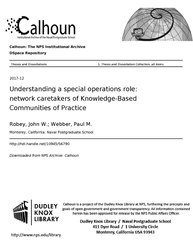File:Understanding a special operations role- network caretakers of Knowledge-Based Communities of Practice (IA understandingspe1094556790).pdf

Original file (1,275 × 1,650 pixels, file size: 1.23 MB, MIME type: application/pdf, 90 pages)
| This is a file from the Wikimedia Commons. Information from its description page there is shown below. Commons is a freely licensed media file repository. You can help. |
Summary
| Understanding a special operations role: network caretakers of Knowledge-Based Communities of Practice
( |
||
|---|---|---|
| Author |
|
|
| Title |
Understanding a special operations role: network caretakers of Knowledge-Based Communities of Practice |
|
| Publisher |
Monterey, California: Naval Postgraduate School |
|
| Description |
The success of special operations often depends upon building and sustaining relationships with partners. Because of the unconventional environment in which we operate, relationships can also be non-standard, including academics, reporters, and private industry. By creating a community of practice, individuals in special operations may be able to connect groups of subject-matter experts who share a deep interest in a particular activity and, through regular interaction with special operations, learn how to engage more effectively in this activity. The work of this thesis is two-fold: building a Knowledge-Based Community of Practice and applying this design method to the authors' case study of Libya. This research offers a partial solution by bolstering a deeper environmental understanding through the creation of such a Knowledge-Based Community of Practice, consisting of a spectrum of individuals with differing perspectives, to engage in iterated structured dialogues. The structure, design, and life cycle of a community of practice, as well as the types and frequencies of interactions and implications of the post-information age are explored. The design methods are rooted in Army doctrine as a method of structuring interactions and distilling information to local planners. Big data sets are implemented to back-stop information from structured sessions. In short, the authors reflect on the establishment and sustainment of a community of practice to better connect with subject-matter experts who care to bring to bear a more complete understanding of an operational environment prior to, during, or in order to avoid altogether the application of military force. Subjects: Army Design Methodology; big data; communities of practice; design; knowledge management; knowledge; learning; Libya; organizational design; SOCAFRICA; Special Operations; strategic arena |
|
| Language | English | |
| Publication date | December 2017 | |
| Current location |
IA Collections: navalpostgraduateschoollibrary; fedlink |
|
| Accession number |
understandingspe1094556790 |
|
| Source | ||
| Permission (Reusing this file) |
This publication is a work of the U.S. Government as defined in Title 17, United States Code, Section 101. Copyright protection is not available for this work in the United States. | |
Licensing
| Public domainPublic domainfalsefalse |
This work is in the public domain in the United States because it is a work prepared by an officer or employee of the United States Government as part of that person’s official duties under the terms of Title 17, Chapter 1, Section 105 of the US Code.
Note: This only applies to original works of the Federal Government and not to the work of any individual U.S. state, territory, commonwealth, county, municipality, or any other subdivision. This template also does not apply to postage stamp designs published by the United States Postal Service since 1978. (See § 313.6(C)(1) of Compendium of U.S. Copyright Office Practices). It also does not apply to certain US coins; see The US Mint Terms of Use.
|
 | |
| This file has been identified as being free of known restrictions under copyright law, including all related and neighboring rights. | ||
https://creativecommons.org/publicdomain/mark/1.0/PDMCreative Commons Public Domain Mark 1.0falsefalse
Captions
Items portrayed in this file
depicts
File history
Click on a date/time to view the file as it appeared at that time.
| Date/Time | Thumbnail | Dimensions | User | Comment | |
|---|---|---|---|---|---|
| current | 16:24, 25 July 2020 |  | 1,275 × 1,650, 90 pages (1.23 MB) | Fæ | FEDLINK - United States Federal Collection understandingspe1094556790 (User talk:Fæ/IA books#Fork8) (batch 1993-2020 #31232) |
File usage
Metadata
This file contains additional information, probably added from the digital camera or scanner used to create or digitize it.
If the file has been modified from its original state, some details may not fully reflect the modified file.
| Short title | Understanding a special operations role: network caretakers of Knowledge-Based Communities of Practice |
|---|---|
| Author | Robey, John W., Webber, Paul M. |
| Software used | Robey, John W., Webber, Paul M. |
| Conversion program | Adobe PDF Library 11.0 |
| Encrypted | no |
| Page size | 612 x 792 pts (letter) |
| Version of PDF format | 1.4 |


